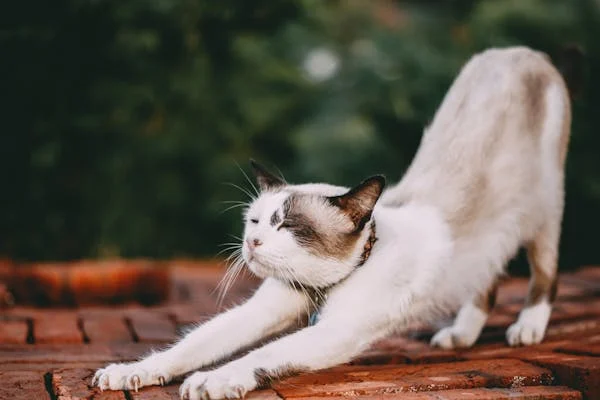Obesity is a growing issue among cats, just as it is in humans. An overweight cat is at a higher risk for many health problems, including diabetes, arthritis, and heart disease. If your feline friend needs to shed some pounds, it’s essential to do it in a safe and gradual manner to avoid stress or health issues. Here’s a guide to help your cat lose weight safely.
1. Consult with Your Veterinarian
Before embarking on a weight-loss journey for your cat, consult your vet. They can assess your cat’s overall health, determine an ideal weight goal, and rule out any underlying conditions that could be contributing to weight gain, such as hypothyroidism or other metabolic issues.
Your vet may also recommend specific dietary changes and suggest an appropriate weight-loss program that suits your cat’s needs.
2. Determine the Ideal Weight for Your Cat
Once you have the vet’s input, you need to determine what your cat’s ideal weight should be. Cats are typically considered overweight if they are 10-20% above their ideal body weight and obese if they are more than 20% above their ideal weight. Your vet can provide a specific weight target based on your cat’s breed, age, and activity level.
3. Control Portion Sizes
Many cats are free-fed (given food available all day), which can lead to overeating. Portion control is crucial for weight loss. Follow the guidelines on your cat’s food packaging or the vet’s recommendation for how much to feed your cat daily. Measure out your cat’s meals rather than guessing.
You can split the daily food allowance into multiple smaller meals to mimic your cat’s natural hunting behavior and avoid overfeeding.
4. Choose the Right Food
Not all cat foods are created equal. High-quality, balanced diets rich in protein and low in carbohydrates can help your cat lose weight. Consider switching to a weight-management formula if your cat is significantly overweight, but only under the guidance of your veterinarian.
Protein-rich, low-carb diets tend to be more satisfying and help maintain muscle mass while reducing fat. Avoid high-calorie treats or table scraps, as they can quickly add unnecessary calories.
5. Increase Play and Physical Activity
One of the best ways to help your cat lose weight is through increased activity. Cats are natural hunters, and play mimics this instinct. Encourage your cat to move more by providing interactive toys, laser pointers, or feather wands.
Consider investing in puzzle feeders or toys that dispense food to make mealtimes more active. Cats can be notoriously lazy, so it might take a little extra effort to engage them in regular play sessions. Aim for at least two 10-15 minute play sessions each day to keep your cat stimulated and burning calories.
6. Monitor Progress Regularly
It’s important to regularly monitor your cat’s weight and adjust their diet and activity as needed. Weigh your cat once a week or at least every two weeks. Most cats should lose about 0.5 to 2% of their body weight per week. If your cat isn’t losing weight or is losing it too quickly, consult your veterinarian for advice.
7. Avoid Crash Diets and Sudden Weight Loss
Cats, particularly overweight ones, are prone to a condition called hepatic lipidosis (fatty liver disease) if they lose weight too quickly. This condition can be life-threatening and occurs when a cat’s liver is overwhelmed by too much fat being mobilized for energy.
Weight loss should be slow and steady. A general rule of thumb is to aim for 1-2% weight loss per week. Never put your cat on a crash diet or drastically reduce their food intake without professional guidance.
8. Use Low-Calorie Treats Sparingly
Treats are a way to bond with your cat, but they can also pack a lot of extra calories. Instead of cutting treats out entirely, opt for low-calorie alternatives. Freeze-dried meat or small pieces of cooked chicken can be a good option.
Remember, treats should make up less than 10% of your cat’s daily calorie intake. Factor these into the total daily calorie count to ensure your cat doesn’t exceed their limit.
9. Consider a Weight-Loss Food Puzzle
Feeding puzzles or slow-feeder bowls can encourage your cat to eat more slowly and work for their food, which can help with portion control and increase activity. Cats often enjoy the mental stimulation that comes with figuring out how to access their food, making mealtime more engaging and rewarding.
10. Be Patient and Consistent
Weight loss takes time, and consistency is key. Cats are creatures of habit, so any changes to their diet or routine should be gradual. Be patient and stick to the plan laid out by your vet, and avoid making sudden changes that might stress your cat. Over time, you’ll see the benefits of healthier weight on your cat’s overall well-being.
Conclusion
Helping your cat lose weight is about finding a balance between the right diet, portion control, and increased physical activity. Always consult with your vet before making changes to your cat’s routine to ensure the weight loss process is safe and healthy. By making gradual, consistent changes, you’ll help your cat live a longer, happier, and more energetic life.

